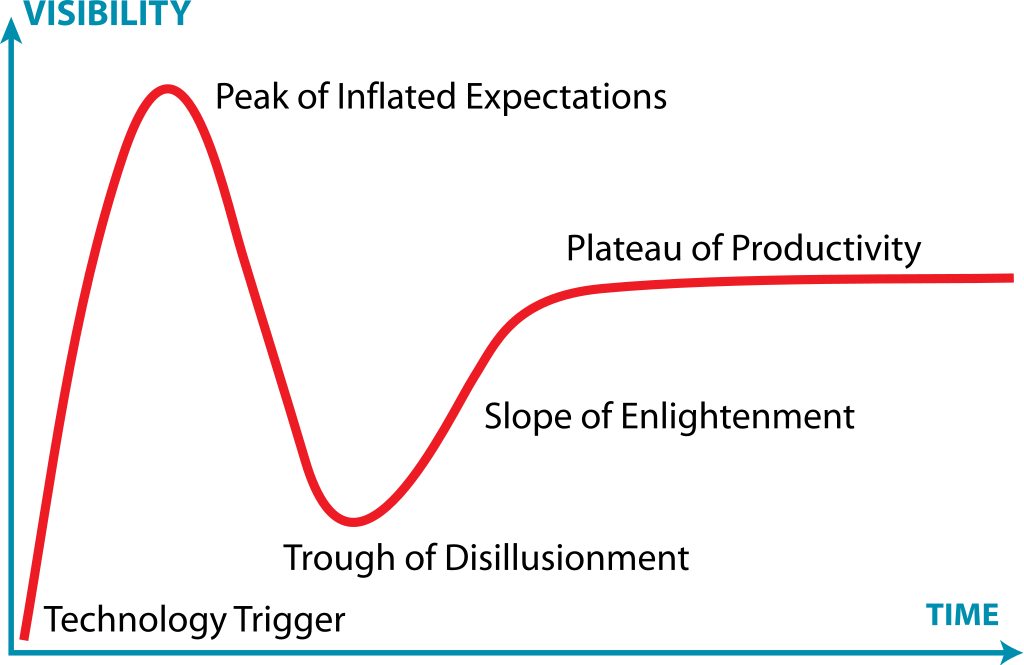Platform engineering officially entered the Gartner Hype Cycle for Emerging Technologies in 2022, consolidating it as the improvement for developer teams we already know it is. But what is the Gartner Hype Cycle, and how does it affect the evolution of a given technology?
The Gartner Hype Cycle
Every year, Gartner, the technological research and consulting firm, releases the Gartner Hype Cycle. It provides a graphic representation of the evolution of visibility, maturity, and adoption of specific technologies. It combines the typical progression of emerging technology (from overenthusiasm to disappointment because of unrealistic expectations, to understanding) with its natural maturity curve.

Hype level, engineering maturity
Taking the community response into account makes this a very powerful tool to discern where technology really is, in terms of stability and mainstream adoption. Businesses can use the hype cycle to guide technology decisions in accordance with their level of comfort with risk since each phase of the cycle has its own risks and opportunities.
How does it work?
The hype cycle consists of five phases:

Technology (or Innovation) Trigger. The technology is conceptualized: it may be a product, a concept, or an idea that attracts media attention and, because of it, is considered a breakthrough. Early adopters are interested in the technology but usually can’t access it because it is only available to a restricted set of users (research labs and startups).
Peak of Inflated Expectations. Everyone is talking about technology. It’s used as a buzzword and it generates a lot of interest from vendors. Here is when early adopters can actually adopt it. There are a lot of reviews of promising experiences, and also of catastrophic ones, which begin to appear.
Trough of Disillusionment. When the technology doesn’t fulfill the impossible standards imposed by the public, disappointment arrives. Some producers drop their products due to the flaws they now see in the technology. The technology evolves into its next generation with only a small percentage (up to 5%) of the audience adopting it.
Slope of Enlightenment. The technology is familiar to more people, and it’s more mature now. Without the expectation of transforming the world overnight, companies implement or test it in their environments. Second and third generations of innovation emerge, presenting proven solutions to specific problems and industrial use cases. As a result, adoption rises closer to 20% of the audience as the technology reaches its next maturity phase. The perceived value is now closer to reality.
Plateau of Productivity. Mainstream adoption (30% or more of the audience): the technology is now more reliable and understood. It becomes widely implemented and has a growing community around it.
Different technologies have different timing, and the Hype Cycle takes that into account, specifying how long it will take (according to Garter’s research) to reach the Plateau of Productivity for each of them. Some progress faster than others, and some disappear completely in the process (depending on what was the perceived value at the beginning, whether they live up to that expectation, and whether the industry is in a position to assume risk).
Platform Engineering enters the Hype Cycle
Platform Engineering (defined by Gartner as “the discipline of building and operating self-service internal developer platforms (IDPs) for software delivery and life cycle management”) appears on the Gartner Hype Cycle for Emerging Technologies, published on 25 July 2022, as well as on the Gartner Hype Cycle for Software Engineering, published on 1 of August 2022.

It is well established in the Innovation Trigger phase and with an expectancy of reaching the Plateau of Productivity in 2 to 5 years. We can also see some familiar technologies in the graph, like cloud-native architecture, well into its way to the Plateau of Productivity, and microservices, finally reaching the end of the Trough of Disillusionment.

Napptive enables developer self-service. We encourage you to try our playground and experience accelerated cloud-native development. It’s completely free*, all you need to do is simply [sign up](playground.napptive.dev/campaign_source=blo..) and get started!*
Platform Engineering was introduced as a solution to improve the developer experience, reducing employee frustration and attrition. We discuss the term and what it encompasses in this article, where we talk about putting the focus on the developer for this technology. Gartner agrees, and acknowledges the importance of taking care of the dev team in its report “A Software Engineering Leader’s Guide to Improving Developer Experience”, which underlines that an Internal Developer Platform, while essential, is not enough:
“Internal developer portals serve as the interface through which developers can discover and access internal developer platform capabilities.”
An IDP built by a platform team, following a Platform as a Product approach, will be tailored to the needs of your dev team. Also, a dedicated developer portal, with service catalog capabilities that your team can use to access said IDP, will help them solve the underlying workflow and configuration issues affecting their experience. We dive deeper into the benefits of an Internal Developer Platform in this article, highlighting how crucial it is to create one with your dev team’s input.
The goal of Platform Engineering is to make life easier for developers, reducing cognitive load, developer toil, and repetitive manual work. To know the specific issues in your team, you need to listen to them. That is the only way to create an environment where they can thrive.
In case you have not yet tried Napptive, we encourage you to sign up for free and discover how we are helping propel the development of cloud-native apps.
